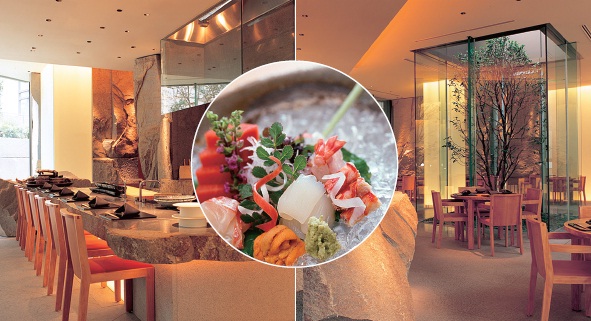Christine Cunanan-Miki enjoys simple and sophisticated kaiseki dining at the Grand Hyatt hotel
Those looking for a different kind of Japanese dining experience should head for Shunbou, the kaiseki restaurant of the Grand Hyatt Tokyo. In a setting that is both modern and classic, you’ll be treated to a visual and culinary feast. Imagine a restaurant of glass, wood and granite in a garden of ponds and bamboo trees. This is the impressive and yet unobtrusive setting Takashi Sugimoto, one of Japan’s foremost restaurant designers, conceptualized for a contemporary kaiseki dinner that is prepared in an open kitchen and served in beautiful pottery sourced from all over Japan.
Shunbou means seasonal kitchen in Japanese. On the other hand, kaiseki is the Japanese equivalent of haute cuisine, and it usually involves the meticulous preparation and serving of a series of small but tasty (in a subtle way) dishes that are then arranged expertly on specially chosen plates and bowls. The ingredients for each dish and the order in which these are served are all carefully decided for reasons that may not be obvious at the outset. However, the kaiseki chef always hopes that, by the end of the meal, his intended order, balance and harmony will become apparent. Many foreigners who have a kaiseki meal for the first time either feel that the flavors are too bland or the portions too small. However, kaiseki is a reflection of the Japanese pysche: the preference for subtlety and the appreciation of one small experience at a time. It is so much a part of the Japan experience that no foreigner should leave Japan without having at least one proper kaiseki meal.
And few restaurants can be as ideal for a kaiseki meal in Tokyo today as Shunbou. Of course, there are many traditional Japanese establishments serving classical cuisine in this city; but, frankly, many of them seem to be stuck in a time warp, still operating in the Edo era when we’re now in the 21st century. While having a formal dinner in an ancient wooden house in Kagurazaka may be a pleasant novelty, any Japanese will tell you that this is no longer the real Tokyo.
At Shunbou, you don’t get the fantasy image of old Japan. You get Tokyo as it is now, and kaiseki cooking as it has evolved today—into a more relaxed meal that is all about a fresh, simple and yet undeniably sophisticated style and natural flavors coaxed out of the choicest meat, fish and vegetables that—unlike in the old days— can now be easily sourced from the farthest corners of the country. The night we were there, for instance, the chef prepared a tofu and fugu (blowfish) appetizer with a tangy sauce of vinegar and carrot; and a tsukuri (sliced raw fish) plate of toro (fatty tuna), hirame (flatfish) and amaebi (sweet shrimp) that just melted in our mouths. We then savored a very tender duck in a piquant plum vinegar and Japanese leek sauce. Instead of one main dish, we enjoyed four small servings consisting of grilled butterfish, dried Japanese sardines, deep-fried ice fish and a delicate stew of tilefish and anglefish. Each of the fish selections was seasoned so properly that even today I can still remember the flavors of each and tell them apart. For dessert, the homemade strawberry ice cream with a black bean sauce and the beautifully presented pumpkin pudding were big winners.
WHAT TO EAT
The seasonal “Koetsu (Joy of Eating)” and “Hatsukari (Ume Рlum Tree)” kaiseki set menus offer a little hit of everything so they’re perfect for those who want the authentic experience. A lady sitting by herself at the next table also seemed to be relishing every bite of the grilled Japanese sirloin and vegetables in a pot that looked absolutely delicious!
WHAT TO DRINK
Sake, of course! Two choices that compliment the meal and bring out the subtle flavors are the Daiginjo Jokigen, a fruity and crisp sake from Yamagata, and the Daiginjo Daishichi, a full-bodied sake from Fukushima.
WHERE TO SIT
You’re in beautiful and calming Japanese-style surroundings so every table oilers a glimpse of the action rather than a lull head-on visual. However, the most enjoyable seats are probably at the counter.
MOW MUCH DID IT COST?
Plan on spending between ¥30,000 and ¥40,000 for a kaiseki set menu for two and several Listings ill sake.
WHO GOES THERE?
Japanesc and Foreign executives, including several who always make it a point to eat here when on a business trip to Tokyo. The restaurant is also a favorite of residents from nearby Roppongi and Azabu neighborhoods.
SHUNBOU
Grand Hyatt Tokyo 6F
6-10-3 Roppongi
Minato-ku
tel. 03-4333-8786









